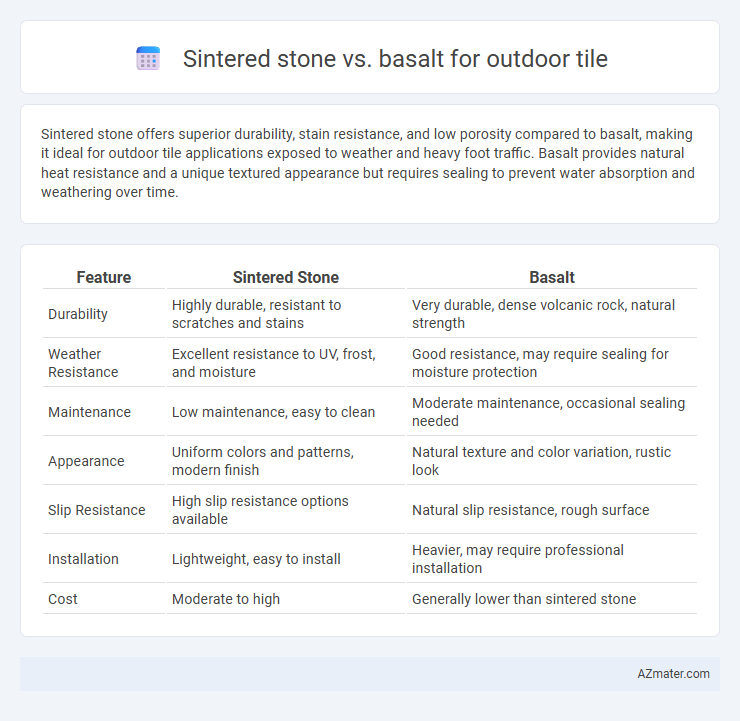Sintered stone offers superior durability, stain resistance, and low porosity compared to basalt, making it ideal for outdoor tile applications exposed to weather and heavy foot traffic. Basalt provides natural heat resistance and a unique textured appearance but requires sealing to prevent water absorption and weathering over time.
Table of Comparison
| Feature | Sintered Stone | Basalt |
|---|---|---|
| Durability | Highly durable, resistant to scratches and stains | Very durable, dense volcanic rock, natural strength |
| Weather Resistance | Excellent resistance to UV, frost, and moisture | Good resistance, may require sealing for moisture protection |
| Maintenance | Low maintenance, easy to clean | Moderate maintenance, occasional sealing needed |
| Appearance | Uniform colors and patterns, modern finish | Natural texture and color variation, rustic look |
| Slip Resistance | High slip resistance options available | Natural slip resistance, rough surface |
| Installation | Lightweight, easy to install | Heavier, may require professional installation |
| Cost | Moderate to high | Generally lower than sintered stone |
Introduction to Sintered Stone and Basalt
Sintered stone, a composite material made from natural minerals fused under high heat and pressure, offers exceptional durability, stain resistance, and low porosity ideal for outdoor tile applications. Basalt, a dense volcanic rock, is naturally resistant to weathering, abrasion, and thermal fluctuations, making it a reliable choice for exterior surfaces. Both materials excel in longevity and aesthetic appeal but differ in composition and performance characteristics critical for outdoor tile selection.
What is Sintered Stone?
Sintered stone is an engineered material composed of natural minerals subjected to extreme heat and pressure, resulting in a dense, non-porous surface ideal for outdoor tile applications due to its durability and resistance to weathering. Unlike basalt, which is a volcanic rock formed through natural cooling of lava, sintered stone offers enhanced uniformity, stain resistance, and a broader range of design options. Its thermal stability and UV resistance make it a superior choice for outdoor environments where longevity and maintenance are critical.
What is Basalt?
Basalt is a dense, volcanic igneous rock formed from the rapid cooling of basaltic lava, characterized by its durability and natural resistance to weathering, making it ideal for outdoor tile applications. Its fine-grained texture and dark coloration provide a unique aesthetic, often preferred for modern landscaping and architectural projects. Compared to sintered stone, basalt offers superior heat resistance and natural slip resistance, essential for outdoor environments exposed to varying weather conditions.
Aesthetic Differences: Sintered Stone vs Basalt
Sintered stone offers a wide variety of colors, patterns, and textures, mimicking natural materials with high precision and uniformity, making it ideal for modern, versatile outdoor tile designs. Basalt, a naturally forming volcanic rock, showcases a more rustic and earthy aesthetic with unique grain patterns and deep, rich tones that weather beautifully over time. The consistent finish of sintered stone contrasts with basalt's organic variations, providing distinct visual choices depending on design goals for outdoor spaces.
Durability and Strength Comparison
Sintered stone exhibits exceptional durability and high resistance to scratches, stains, and weathering, making it ideal for outdoor tile applications. Basalt offers impressive natural strength and robustness, with excellent resistance to thermal shock and harsh environmental conditions. Both materials provide superior performance, but sintered stone often surpasses basalt in surface hardness and maintenance ease, ensuring long-lasting outdoor tile solutions.
Weather Resistance and Outdoor Suitability
Sintered stone exhibits exceptional weather resistance due to its non-porous structure, making it highly suitable for outdoor tiles in extreme climates, including resistance to UV rays, frost, and moisture. Basalt, a natural volcanic rock, offers robust durability and thermal stability but can be more porous and susceptible to staining or erosion without proper sealing. Both materials are excellent for outdoor applications, though sintered stone requires less maintenance and provides superior long-term performance in diverse weather conditions.
Maintenance Requirements
Sintered stone offers superior resistance to stains and scratches, requiring minimal maintenance compared to basalt, which is porous and prone to weathering without proper sealing. Outdoor basalt tiles demand regular sealing and cleaning to prevent moisture absorption and surface erosion. Both materials benefit from periodic inspections, but sintered stone's durability reduces the frequency of intensive upkeep.
Cost Analysis: Sintered Stone vs Basalt
Sintered stone typically offers a more cost-effective solution for outdoor tile applications compared to basalt, with prices averaging 30-40% lower due to its engineered manufacturing process. Basalt, a natural volcanic rock, incurs higher extraction and processing costs, which reflect in its market price, often making it 50-70% more expensive than sintered stone. Installation and maintenance expenses also favor sintered stone, as its uniformity and durability reduce labor time and long-term upkeep costs.
Environmental Impact and Sustainability
Sintered stone, produced through high-pressure and high-temperature processes using natural minerals, offers exceptional durability and low environmental impact due to its use of abundant raw materials and energy-efficient manufacturing. Basalt, a natural volcanic rock, is highly sustainable as it requires minimal processing and is abundant in nature, resulting in a low carbon footprint when used for outdoor tiles. Both materials provide eco-friendly options, but sintered stone's engineered consistency and recyclability often enhance its sustainability profile compared to quarried basalt.
Which is Best for Outdoor Tiles?
Sintered stone offers exceptional durability, resistance to UV rays, and low water absorption, making it highly suitable for outdoor tiles exposed to varying weather conditions. Basalt, a natural volcanic rock, provides excellent strength and slip resistance but may require more maintenance to prevent surface degradation over time. Considering longevity, aesthetic versatility, and weather resistance, sintered stone generally outperforms basalt as the best choice for outdoor tile applications.

Infographic: Sintered stone vs Basalt for Outdoor Tile
 azmater.com
azmater.com